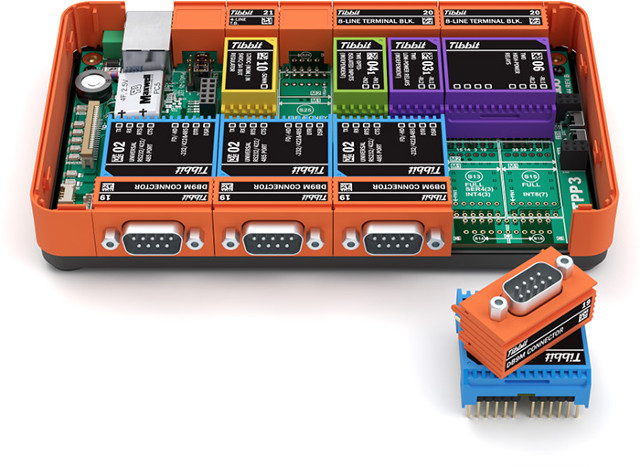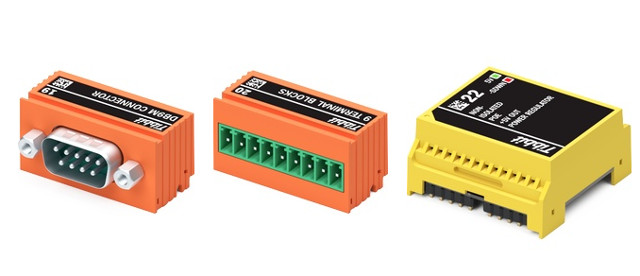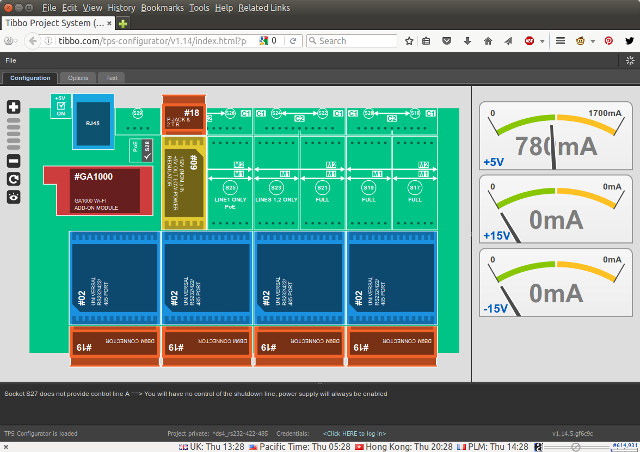If you’ve found yourself needing to quickly demo a system that does not look like a mess of wire to a customer, or your project is requires low production volumes, making the cost of designing your own and mass-producing the hardware prohibitive, Tibbo Project System might be worth looking into. It features an almost bare board powered by Texas Instruments Sitara processor, and a large area for Tibbit blocks to add features as needed, as well as an enclosure.
 Size 3 Linux Project PCB (LTPP3) specifications:
Size 3 Linux Project PCB (LTPP3) specifications:
- SoC – Texas Instruments Sitara AM335x Cortex A8 processor up to 1.0 GHz
- System Memory – 512 MB DDR3
- Storage – 512 MB NAND flash, 2KB EEPROM, optional micro SD slot
- Connectivity – 10/100M Ethernet (RJ45), optional WiFi (via LW1000 module) and GPRS connectivity (via Tibbit #47)
- Expansion – 51 I/Os:
- 7x tiles
- 14x sockets for Tibbit module including 4x with UART capability up to 921,600 bps, 2x for CAN socket, 8x for “interrupt” blocks, and 1x for PoE
- 14x sockets for Tibbit connectors
- 1x extra socket for Tibbit #37 (RF connector)
- Support for up to 25 relays, up to 47 opto-inputs, PWM outputs, open-collector outputs, or other I/O.
- Audio – Optional 96KHz stereo audio LINE Out, MIC In (via Tibbit #48).
- Misc – 8x LEDs for status and connectivity; setup (MD) and reset buttons; buzzer
- Power Supply – 5V via power barrel. Tibbit blocks allow for other power inputs such as rterminal block, PoE, etc…
- Dimensions – 165×94 mm
- Operating temperature range – -40 ~ +70C.
“Size 3” refers to the different size of Tippo Project System, as they also have older smaller systems based on Size 1 & 2 that do not run Linux. That’s what the bare board looks like.

Now to have a complete project as shown in the first picture, you need to get Size 3 Tibbo Project Box (TPB3) and purchase a few Tibbit blocks and connectors. Tibbit blocks have all their own number, and you can choose the ones you need among about 50 modules that include I/O terminals, serial ports, relays, isolated inputs, power supply blocks, DAC and ADC blocks, sensors and so on. For example, in the picture below I have Tibbit #19 (DB9M connector), #20 (9x terminal blocks), and #22 (Non-isolated PoE).
 There are four options on the software side:
There are four options on the software side:
- Embedded AggreGate – Tibbo’s “Internet of Things integration platform that employs modern network technologies to control, configure, monitor and service different electronic devices.” with support for more than 100 supported communications protocols. A middleware C library allows to access GPIO lines, serial ports, and Tibbit modules.
- Run Node.js applications – Node.js is pre-installed with support with libraries such as serialport and socket.io, and the company’s own.
- Execute TiOS applications – The company’s Tibbo OS (TiOS) is currently being ported to Linux, and once it’s done you’ll be able to run Tibbo BASIC and Tibbo C code with minor modifications. This is especially useful for customer who run such apps on previous platform. Tibbo IDE is used to develop such apps.
- Use the LTPP3 as a generic Linux board – Since the board runs a Red Hat derived Linux distribution, it can be used as any Linux single board computer

The company has also designed an Online Configurator to let customers design and order their own custom system.
LTPP3 board starts at $130, Size 3 Tibbo Project Box (TPB3) at $44, and Tibbit blocks and connectors go for between $2 to $44 (GPRS modem) each. The new system is scheduled to start shipping in May. More details can be found on Tibbo Technology website.
Via HackerBoards

Jean-Luc started CNX Software in 2010 as a part-time endeavor, before quitting his job as a software engineering manager, and starting to write daily news, and reviews full time later in 2011.
Support CNX Software! Donate via cryptocurrencies, become a Patron on Patreon, or purchase goods on Amazon or Aliexpress




